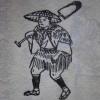Thanks for all the responses, really helps me! It's good to know I probably don't have something factory-made or made recently.
Comments on the kissaki are right on. It appears to have had some amateur work done on it. The boshi looks like it's had some course grinding on it, with some corrosion in the crevasses there. (I didn't include a close up photo of that because I didn't think it would help with basic identification, but some of you were all over it anyway!)
I have been studying the jigane and hamon to see if I could match it up with photos online. I don't think the polish is very good, but with a magnifying glass I feel like I can get an idea how it might look with a good polish. (I can try to post better close up photos, but for now I find it looks like the photo in the link below.)
The jigane seems very fine and dense, really consistent with almost no features like burls, wavy lines, or wood grain-like features. The hamon is very irregular, no real pattern and seems like it would come out well with a good polish.
One photo I found online has (to me) some similarities in those two areas (it should magnify if you click on it after it opens):
http://www.aoijapan.com/img/sword/2015/15199-4.jpg
Not sure if this is a good way to try to narrow down what I have, but I'm learning as I go...



